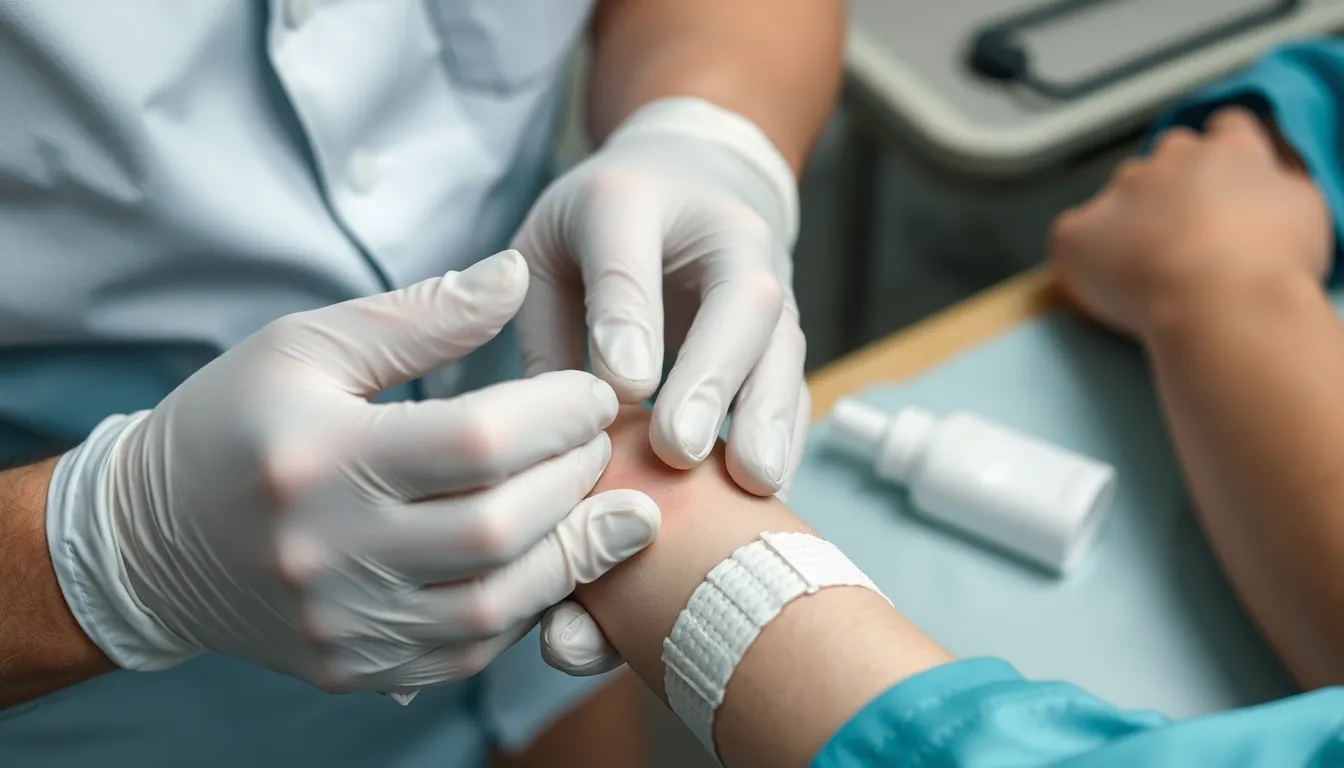Table of Contents
ToggleWhen it comes to skin cuts, not all are created equal. From the classic paper cut that feels like a tiny ninja attack to the battle scars earned in the name of adventure, understanding the types of cuts can be both enlightening and entertaining. Each cut tells a story, whether it’s a minor scrape from a tumble or a deeper gash from a kitchen mishap.
Types Of Cuts On Skin
Skin cuts fall into various categories, each defined by depth, severity, and cause. Minor cuts represent the most common type, often resulting from everyday activities. A paper cut exemplifies this, causing superficial damage and minimal bleeding.
Lacerations describe deeper cuts that penetrate through multiple layers of skin. These injuries often occur during accidents, such as kitchen mishaps with sharp knives. A laceration typically requires careful cleaning and, in some cases, stitches for closure.
Abrasions involve the top layer of skin being scraped off. These cuts can arise from falls or friction against rough surfaces. They may appear as red, raw patches and often heal without significant medical intervention.
Puncture wounds result from sharp objects piercing the skin. Examples include injuries from nails or needles, which tend to be narrow yet deep. Due to their potential for infection, puncture wounds require prompt attention.
Additionally, incisions result from surgical procedures or sharp instruments. Surgeons create incisions intentionally for operations, often leading to clean, precise cuts. Healing times may vary based on the location and size of the incision.
Bite wounds occur when skin is punctured or torn by teeth. Animal and human bites can introduce bacteria, increasing infection risk. Immediate cleaning and medical evaluation are crucial in such cases.
Understanding these cut types helps in managing treatment and care. Recognizing the characteristic features of each injury type fosters appropriate responses, whether treating a small scrape or a deep laceration.
Common Types Of Skin Cuts

Understanding different types of skin cuts aids in identifying appropriate care. Each category has unique characteristics and treatment needs.
Abrasions
Abrasions occur when the skin’s outer layer is scraped off, leading to a raw surface. These shallow injuries result from falls, friction, or scrapes against rough surfaces. While abrasions may cause minor bleeding, they often heal without complications. Cleaning the area with mild soap and water promotes healing and prevents infection. Applying a sterile bandage keeps debris out, supporting recovery. Typical examples include road rash or rug burns.
Lacerations
Lacerations present as deeper cuts that may penetrate through skin layers, sometimes affecting underlying tissues. Such cuts often require stitches or staples for proper closure. Causes can range from accidents with sharp objects to violent encounters. Signs of a laceration include excessive bleeding or wound edges that do not align. Immediate medical evaluation is crucial to assess the injury and decide on appropriate treatment strategies.
Puncture Wounds
Puncture wounds arise from sharp objects piercing the skin, resulting in narrow but deep openings. Common examples include wounds from nails, needles, or animal bites. Due to their depth, puncture wounds carry significant risks for infection, especially if caused by non-sterile objects. Thorough cleaning and assessment by a healthcare professional are vital to ensure proper treatment. Depending on the injury, additional interventions such as tetanus shots or antibiotics might be necessary.
Classification Of Skin Cuts
Skin cuts can be classified based on various characteristics, including depth and shape. Understanding these classifications helps in assessing the severity and appropriate treatment of each type.
Depth Of Cut
Cuts vary in depth, which influences their treatment and healing process. Shallow cuts, often classified as abrasions, affect only the outer layer of skin. These injuries typically heal without medical intervention. On the other hand, deeper cuts are considered lacerations, which can extend through several layers of skin and may require stitches for proper healing. Puncture wounds present a unique challenge; they are usually deep with narrow openings, making it essential to monitor them for signs of infection.
Shape Of Cut
The shape of a cut also plays a crucial role in its classification. Straight cuts, such as those made by a sharp knife, often resemble incisions. These cuts have clean edges and can heal nicely if treated properly. Irregular shapes, resulting from accidents with jagged objects, are typically lacerations. These cuts may have torn or ragged edges, complicating the healing process. Puncture wounds are characterized by their small entry points with a deeper, narrow shape, increasing the risk of infection. Understanding the shape aids in deciding the best course of treatment and care.
Causes Of Skin Cuts
Understanding the causes of skin cuts reveals key factors contributing to their occurrence. Accidental injuries and self-inflicted cuts emerge as primary categories.
Accidental Injuries
Accidental injuries frequently result from everyday activities. Kitchen accidents often lead to cuts from knives or sharp utensils. Engaging in sports can cause lacerations from falls or collisions. Bumps against furniture or sharp objects may also produce minor abrasions. While many cuts are superficial, some may require stitches, especially when depth is significant. Children are particularly susceptible to cuts during play. Using protective gear in risky situations minimizes potential injuries and promotes safety.
Self-Inflicted Cuts
Self-inflicted cuts occur when individuals intentionally harm their skin. Conditions such as self-harm or certain mental health issues often drive these actions. Individuals might use sharp objects like blades or glass to create wounds. These cuts vary in depth and severity, reflecting the underlying emotional distress. Prompt attention from mental health professionals is crucial for those who engage in self-harm. Seeking support not only addresses the immediate injuries but also targets the root causes of the behavior.
Treatment And Care
Proper treatment and care for skin cuts is vital for preventing infections and promoting healing. Following targeted steps ensures effective management of injuries.
First Aid Steps
Assess the cut’s severity immediately before proceeding. Clean the affected area with mild soap and water to eliminate dirt and debris. Apply an antiseptic to reduce the risk of infection. Cover the cut with a sterile dressing or bandage to protect it from further injury. Change the dressing daily and keep an eye out for any signs of infection. If the bleeding continues after applying pressure for 10 minutes, elevate the area above the heart to minimize blood flow. Monitor the injury closely for any changes, ensuring proper healing.
When To Seek Medical Attention
Seek medical attention promptly for deep cuts that expose underlying tissues. Lacerations that cause significant bleeding and do not stop with direct pressure require professional intervention. Puncture wounds can introduce bacteria deep into the skin, necessitating evaluation. Additionally, any cut from a dirty or rusty object should receive immediate care to prevent tetanus. If a wound shows increasing redness, swelling, or pus, a healthcare provider’s advice is essential. Cuts that do not heal after a week may indicate a need for further assessment.
Understanding the different types of skin cuts is crucial for effective treatment and care. Each cut tells a unique story and requires appropriate attention based on its characteristics. From minor abrasions to deeper lacerations and puncture wounds, recognizing the severity and cause can guide individuals in managing their injuries.
Proper first aid and ongoing monitoring play vital roles in promoting healing and preventing complications. It’s essential to seek professional help when necessary, especially for more severe cuts or those at risk of infection. By being informed about skin cuts, individuals can respond confidently and ensure their health and safety.





